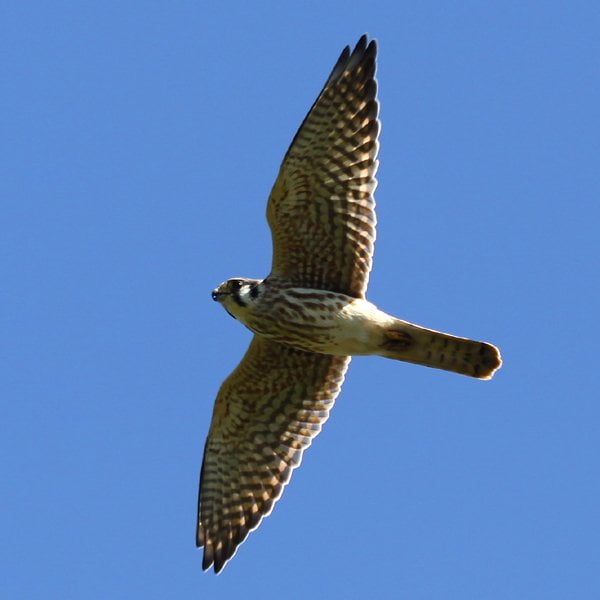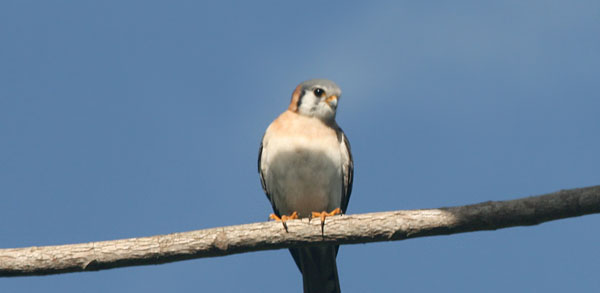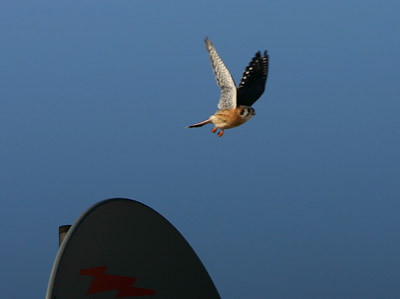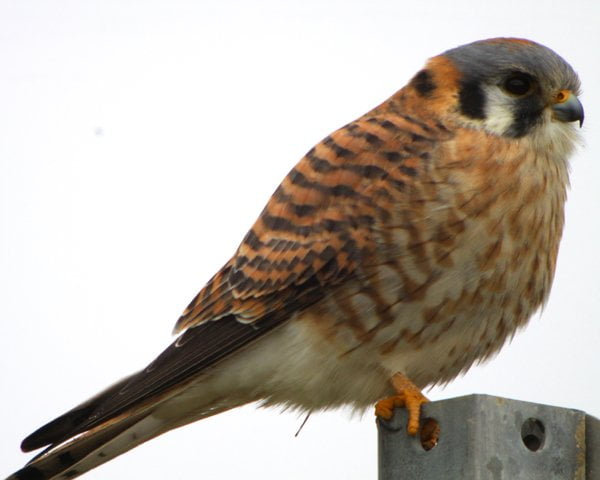Many a lifelong birder picked up his or her first field guide because of raptors. Bird of prey like eagles, hawks, and owls inspire a level of interest or even passion that most other types of birds can only envy. And as cool as the raptor suite seems to casual observers, it reserves some of its greatest charms, like kestrels, for the initiated.
A kestrel is a type of falcon. The 13 or so members of Genus Falco considered kestrels differ from other falcons in that they mostly hover and take their prey on the ground rather than seizing prey on the wing. This is not to say that these pocket predators, so much smaller than hawks and eagles, don’t take other birds; many kestrel species do very well in urban environments where sparrows are both slow and plump. Generally, kestrels subsist on insects, birds, rodents, reptiles, amphibians, and sometimes even house cats (although this last point may be disputed.)

One of the reasons kestrels are such a pleasant surprise is their beautiful plumage, an entirely unexpected blue and orange color scheme in some species that stacks up against the extravagance of any songbird. Male kestrel are much more colorful than the females. Such pronounced sexual color dimorphism is rare among raptors. The female tends to be larger than the male, which is typical among monogamous raptors.
The name “kestrel” comes from the French crecerelle, which originally referred to a noisy bell or clicker. The kestrel’s call, a rapid, high klee klee klee or killy killy killy, deters other birds. The fact that kestrels are able to hover in midair, although not as well as hummingbirds, has earned these birds the general nickname “windhover.”

The Caribbean race of American Kestrel has a pronounced pearlescence to it
Kestrels can be found throughout the world on every continent but Antarctica. The Americas belong exclusively to the aptly-named American Kestrel. This brilliant pocket raptor, which may also answer to sparrow hawk, grasshopper hawk, killy hawk, house hawk, and rusty-crowned falcon, is the smallest and the most widespread falcon in North America and the second smallest in the world. I’m very partial to Falco sparverius because this species is definitely the most interesting bird I’ve spotted from my old Bronx apartment window. The false eye pattern on the back of an American Kestrel’s head deters predators because it seems impossible to surprise.
The Common Kestrel (F. tinnunculus) is widespread throughout Europe, Asia, and Africa, and even makes occasional appearances in North America. This bird, also known as the European Kestrel, Eurasian Kestrel, or Old World Kestrel, shares some of its Mediterranean and Asian territory with the similar, though smaller Lesser Kestrel (F. naumanni).
While the Common and Lesser Kestrels visit Africa, that continent boasts a variety of endemic kestrel species and subspecies. On the mainland, the Fox Kestrel (F. alopex) and Greater or White-eyed Kestrel (F. rupicoloides) are similar to other kestrels, though the Fox weighs in as the largest of all. The Gray Kestrel (F. ardosiaceus) and Dickinson’s Kestrel (F. dickinsoni) differ from other kestrels in that they are both gray (F. ardosiaceus’ common name probably gave that away,) sedentary predators that favor perch hunting. The Madagascar Kestrel (F. newtoni), also called the Malagasy Spotted Kestrel, Newton’s Kestrel, Madagascar Spotted Kestrel, Katiti, or Hitikitike, appears where else but in Madagascar, as does the Banded Kestrel (F. zoniventris). Also roaming islands in this section of the Indian Ocean are the Mauritius Kestrel (F. punctatus) and Seychelles Kestrel (F. araea) the latter the world’s smallest kestrel.
Australia has its own representative, the Nankeen or Australian Kestrel (F. cenchroides). The range of this slim, successful raptor extends to New Guinea and New Zealand. Indonesia is home to the Spotted Kestrel (F. moluccensis), a species striving to defend its title, which is to say its common name, from the upstart Madagascar Spotted Kestrel.















Aren’t they magnificent? I often spot Nankeen kestrels as they hover over the edges of the freeway. They cheer up the drive to work.
Black-shouldered kites (Elanus notatus) are the other common freeway raptor. These black, grey and white birds aren’t quite as delicate in their hovering but they are just as exquisite in their coloration.
One of my favorite poems is “The Windhover” by Victorian poet Gerard Manley Hopkins:
I CAUGHT this morning morning’s minion, king-
dom of daylight’s dauphin, dapple-dawn-drawn Falcon, in his riding
Of the rolling level underneath him steady air, and striding [more]
Love them. Just before leaving Fort Providence I acquired a Kestral that had been hit by a car. It was such an easy bird to care for. As I was leaving for Nunavut in less than a week I tried to get the necessary permit to bring the bird with me to continue it’s care until it could be released. No such luck, and I had to scramble to get the local wildlife officer to take it. I wonder how it made out?
I am not too sure but they are a maginificant bird going up the sky it’s like a rocket my friend once tried to tuch it and “ouch” she god a scar. “don’t tuch it!!1”
i love lreaning about the kestrel it is very interesting i have been learning about about this brid for a while i know it eats grasshoppers,squrrals ,and mice 🙂
I was at the local courthouse getting tags renewed yesterday and walked out into the huge entryway and saw a Kestral trying to figure out how to get out through a window. We have no idea how it managed to get into the building, but I walked up and it leaned into me and I scooped it up and tok it to a wildlife rescue & sanctuary. It was a fledgling and unable to fly well, but seemed in perfect health otherwise. What a beauty! Thanks much “Wild Things” of Dade City Fl for taking such good care of all of the critters we drop off who are in distres or to young to be on their own, and your rescue efforts for those exotics that you take in also. Bravo!!
i dont like kestrel’s i like pigeons because they can race and they will come back to you i have pigeons in my house they all come back to me..yeah i love pigeons i race my pigeons
cool man!
I was reading your description of Kestrels’ diet. House Cats??? I don’t think so!!!!
We have red-shouldered hawks in our backyard and they can’t catch a squirrel.
If a kestrel tried to take a house cat, the kestrel would end up being the meal!!!!
It was Turkey Vultures that triggered my start. Couldn’t believe we had vultures in Canada when I found out.
I spent a couple of hours watching American Kestrels pick off dragonflies in flight and take them back to the cavity for the young. Wish I had a video camera at the time. Those kestrels certainly wouldn’t be picking off any house cats, or even kittens, unless they had a sudden MacBethian attack of “o’er vaulting ambition”…and it would end just as badly for the kestrels as it did for MacBeth. 🙂